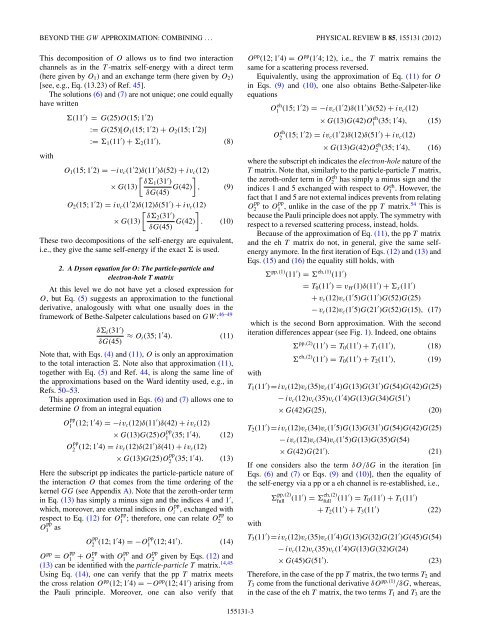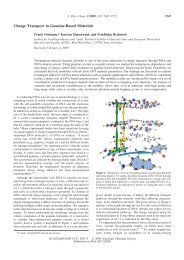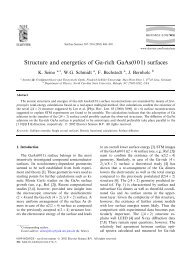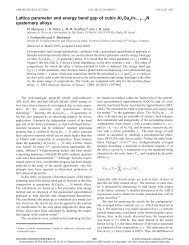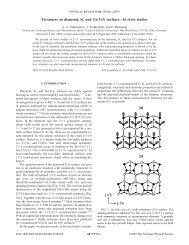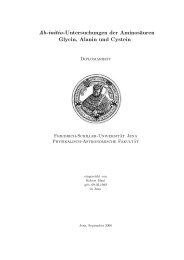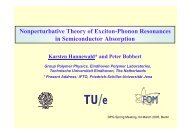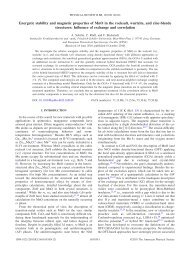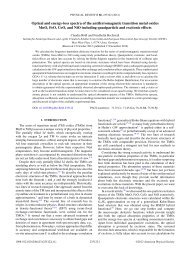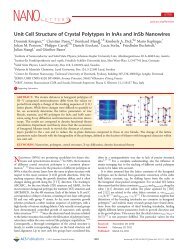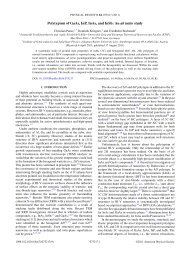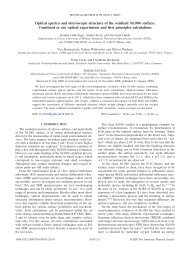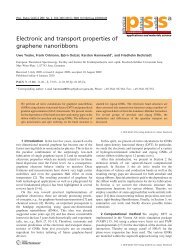Beyond the GW approximation - APS Link Manager - American ...
Beyond the GW approximation - APS Link Manager - American ...
Beyond the GW approximation - APS Link Manager - American ...
Create successful ePaper yourself
Turn your PDF publications into a flip-book with our unique Google optimized e-Paper software.
BEYOND THE <strong>GW</strong> APPROXIMATION: COMBINING ... PHYSICAL REVIEW B 85, 155131 (2012)<br />
This decomposition of O allows us to find two interaction<br />
channels as in <strong>the</strong> T -matrix self-energy with a direct term<br />
(here given by O 1 ) and an exchange term (here given by O 2 )<br />
[see, e.g., Eq. (13.23) of Ref. 45].<br />
The solutions (6) and (7) are not unique; one could equally<br />
have written<br />
with<br />
(11 ′ ) = G(25)O(15; 1 ′ 2)<br />
:= G(25)[O 1 (15; 1 ′ 2) + O 2 (15; 1 ′ 2)]<br />
:= 1 (11 ′ ) + 2 (11 ′ ), (8)<br />
O 1 (15; 1 ′ 2) =−iv c (1 ′ 2)δ(11 ′ )δ(52) + iv c (12)<br />
[ δ1 (31 ′ ]<br />
)<br />
× G(13)<br />
δG(45) G(42) , (9)<br />
O 2 (15; 1 ′ 2) = iv c (1 ′ 2)δ(12)δ(51 ′ ) + iv c (12)<br />
[ δ2 (31 ′ ]<br />
)<br />
× G(13)<br />
δG(45) G(42) . (10)<br />
These two decompositions of <strong>the</strong> self-energy are equivalent,<br />
i.e., <strong>the</strong>y give <strong>the</strong> same self-energy if <strong>the</strong> exact is used.<br />
2. A Dyson equation for O: The particle-particle and<br />
electron-hole T matrix<br />
At this level we do not have yet a closed expression for<br />
O, butEq.(5) suggests an <strong>approximation</strong> to <strong>the</strong> functional<br />
derivative, analogously with what one usually does in <strong>the</strong><br />
framework of Be<strong>the</strong>-Salpeter calculations based on <strong>GW</strong>: 46–49<br />
δ i (31 ′ )<br />
δG(45) ≈ O i(35; 1 ′ 4). (11)<br />
Note that, with Eqs. (4) and (11), O is only an <strong>approximation</strong><br />
to <strong>the</strong> total interaction . Note also that <strong>approximation</strong> (11),<br />
toge<strong>the</strong>r with Eq. (5) and Ref. 44, is along <strong>the</strong> same line of<br />
<strong>the</strong> <strong>approximation</strong>s based on <strong>the</strong> Ward identity used, e.g., in<br />
Refs. 50–53.<br />
This <strong>approximation</strong> used in Eqs. (6) and (7) allows one to<br />
determine O from an integral equation<br />
O pp<br />
1 (12; 1′ 4) =−iv c (12)δ(11 ′ )δ(42) + iv c (12)<br />
× G(13)G(25)O pp<br />
1 (35; 1′ 4), (12)<br />
O pp<br />
2 (12; 1′ 4) = iv c (12)δ(21 ′ )δ(41) + iv c (12)<br />
× G(13)G(25)O pp<br />
2 (35; 1′ 4). (13)<br />
Here <strong>the</strong> subscript pp indicates <strong>the</strong> particle-particle nature of<br />
<strong>the</strong> interaction O that comes from <strong>the</strong> time ordering of <strong>the</strong><br />
kernel GG (see Appendix A). Note that <strong>the</strong> zeroth-order term<br />
in Eq. (13) has simply a minus sign and <strong>the</strong> indices 4 and 1 ′ ,<br />
which, moreover, are external indices in O pp<br />
i<br />
, exchanged with<br />
respect to Eq. (12) for O pp<br />
1<br />
; <strong>the</strong>refore, one can relate Opp<br />
2<br />
to<br />
O pp<br />
1<br />
as<br />
O pp<br />
2 (12; 1′ 4) =−O pp<br />
1 (12; 41′ ). (14)<br />
O pp = O pp<br />
1 + Opp 2<br />
with O pp<br />
1<br />
and O pp<br />
2<br />
given by Eqs. (12) and<br />
(13) can be identified with <strong>the</strong> particle-particle T matrix. 14,45<br />
Using Eq. (14), one can verify that <strong>the</strong> pp T matrix meets<br />
<strong>the</strong> cross relation O pp (12; 1 ′ 4) =−O pp (12; 41 ′ ) arising from<br />
<strong>the</strong> Pauli principle. Moreover, one can also verify that<br />
O pp (12; 1 ′ 4) = O pp (1 ′ 4; 12), i.e., <strong>the</strong> T matrix remains <strong>the</strong><br />
same for a scattering process reversed.<br />
Equivalently, using <strong>the</strong> <strong>approximation</strong> of Eq. (11) for O<br />
in Eqs. (9) and (10), one also obtains Be<strong>the</strong>-Salpeter-like<br />
equations<br />
O1 eh (15; 1′ 2) =−iv c (1 ′ 2)δ(11 ′ )δ(52) + iv c (12)<br />
× G(13)G(42)O1 eh (35; 1′ 4), (15)<br />
O2 eh (15; 1′ 2) = iv c (1 ′ 2)δ(12)δ(51 ′ ) + iv c (12)<br />
× G(13)G(42)O2 eh (35; 1′ 4), (16)<br />
where <strong>the</strong> subscript eh indicates <strong>the</strong> electron-hole nature of <strong>the</strong><br />
T matrix. Note that, similarly to <strong>the</strong> particle-particle T matrix,<br />
<strong>the</strong> zeroth-order term in O2 eh has simply a minus sign and <strong>the</strong><br />
indices 1 and 5 exchanged with respect to O1 eh . However, <strong>the</strong><br />
fact that 1 and 5 are not external indices prevents from relating<br />
O pp<br />
2<br />
to O pp<br />
1 , unlike in <strong>the</strong> case of <strong>the</strong> pp T matrix.54 This is<br />
because <strong>the</strong> Pauli principle does not apply. The symmetry with<br />
respect to a reversed scattering process, instead, holds.<br />
Because of <strong>the</strong> <strong>approximation</strong> of Eq. (11), <strong>the</strong> pp T matrix<br />
and <strong>the</strong> eh T matrix do not, in general, give <strong>the</strong> same selfenergy<br />
anymore. In <strong>the</strong> first iteration of Eqs. (12) and (13) and<br />
Eqs. (15) and (16) <strong>the</strong> equality still holds, with<br />
pp,(1) (11 ′ ) = eh,(1) (11 ′ )<br />
= T 0 (11 ′ ) = v H (1)δ(11 ′ ) + x (11 ′ )<br />
+ v c (12)v c (1 ′ 5)G(11 ′ )G(52)G(25)<br />
− v c (12)v c (1 ′ 5)G(21 ′ )G(52)G(15), (17)<br />
which is <strong>the</strong> second Born <strong>approximation</strong>. With <strong>the</strong> second<br />
iteration differences appear (see Fig. 1). Indeed, one obtains<br />
pp,(2) (11 ′ ) = T 0 (11 ′ ) + T 1 (11 ′ ), (18)<br />
eh,(2) (11 ′ ) = T 0 (11 ′ ) + T 2 (11 ′ ), (19)<br />
with<br />
T 1 (11 ′ ) = iv c (12)v c (35)v c (1 ′ 4)G(13)G(31 ′ )G(54)G(42)G(25)<br />
− iv c (12)v c (35)v c (1 ′ 4)G(13)G(34)G(51 ′ )<br />
× G(42)G(25), (20)<br />
T 2 (11 ′ ) = iv c (12)v c (34)v c (1 ′ 5)G(13)G(31 ′ )G(54)G(42)G(25)<br />
− iv c (12)v c (34)v c (1 ′ 5)G(13)G(35)G(54)<br />
× G(42)G(21 ′ ). (21)<br />
If one considers also <strong>the</strong> term δO/δG in <strong>the</strong> iteration [in<br />
Eqs. (6) and (7) or Eqs. (9) and (10)], <strong>the</strong>n <strong>the</strong> equality of<br />
<strong>the</strong> self-energy via a pp or a eh channel is re-established, i.e.,<br />
pp,(2)<br />
full<br />
(11 ′ ) = eh,(2)<br />
full<br />
(11 ′ ) = T 0 (11 ′ ) + T 1 (11 ′ )<br />
+ T 2 (11 ′ ) + T 3 (11 ′ ) (22)<br />
with<br />
T 3 (11 ′ ) = iv c (12)v c (35)v c (1 ′ 4)G(13)G(32)G(21 ′ )G(45)G(54)<br />
− iv c (12)v c (35)v c (1 ′ 4)G(13)G(32)G(24)<br />
× G(45)G(51 ′ ). (23)<br />
Therefore, in <strong>the</strong> case of <strong>the</strong> pp T matrix, <strong>the</strong> two terms T 2 and<br />
T 3 come from <strong>the</strong> functional derivative δO pp,(1) /δG, whereas,<br />
in <strong>the</strong> case of <strong>the</strong> eh T matrix, <strong>the</strong> two terms T 1 and T 3 are <strong>the</strong><br />
155131-3


